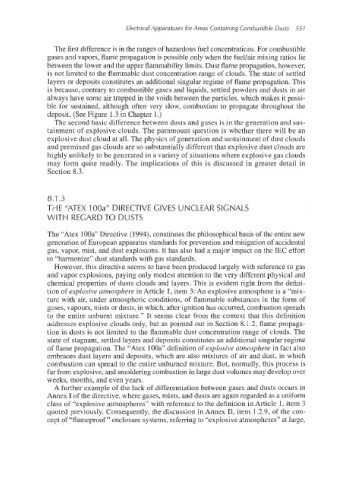Page 584 - Dust Explosions in the Process Industries
P. 584
ElectricalApparatuses for Areas Containing Combustible Dusts 55 T
The first differenceis in the ranges of hazardous fuel concentrations.For combustible
gases and vapors, flame propagation is possible only when the fueVair mixing ratios lie
between the lower and the upper flammability limits. Dust flame propagation,however,
is not limited to the flamable dust concentration range of clouds. The state of settled
layers or deposits constitutes an additional singular regime of flame propagation. This
is because, contrary to combustible gases and liquids, settled powders and dusts in air
always have some air trapped in the voids between the particles, which makes it possi-
ble for sustained, although often very slow, combustion to propagate throughout the
deposit. (See Figure 1.3in Chapter 1.)
The second basic difference between dusts and gases is in the generation and sus-
tainment of explosive clouds. The paramount question is whether there will be an
explosive dust cloud at all. The physics of generation and sustainment of dust clouds
and premixed gas clouds are so substantially different that explosive dust clouds are
highly unlikely to be generated in a variety of situations where explosive gas clouds
may form quite readily. The implications of this is discussed in greater detail in
Section 8.3.
8.1.3
THE ”ATEX 1OOa” DIRECTIVE GIVES UNCLEAR SIGNALS
WITH REGAR.DTO DUSTS
The “Atex lOOa” Directive (1994), constitutes the philosophical basis of the entire new
generation of European apparatus standards for prevention and mitigation of accidental
gas, vapor, mist, and dust explosions. It has also had a major impact on the EC effort
to “harmonize” dust standards with gas standards.
However, this directive seems to have been produced largely with reference to gas
and vapor explosions, paying only modest attention to the very different physical and
chemical properties of dusts clouds and layers. This is evident right from the defini-
tion of explosive atmosphere in Article 1, item 3: An explosive atmosphere is a “mix-
ture with air, under atmospheric conditions, of flammable substances in the form of
gases, vapours, mists or dusts, in which, after ignition has occurred, combustion spreads
to the entire unburnt mixture.” It seems clear from the context that this definition
addresses explosive clouds only, but as pointed out in Section 8.1.2, flame propaga-
tion in dusts is not limited to the flammable dust concentration range of clouds. The
state of stagnant, settled layers and deposits constitutes an additional singular regime
of flame propagation. The “Atex 1OOa” definition of explosive atmosphere in fact also
embraces dust layers and deposits, which are also mixtures of air and dust, in which
Combustion can spread to the entire unburned mixture. But, normally, this process is
far from explosive, and smolderingcombustionin large dust volumes may develop over
weeks, months, and even years.
A further example of the lack of differentiation between gases and dusts occurs in
Annex I of the directive, where gases, mists, and dusts are again regarded as a uniform
class of “explosive atmospheres” with reference to the definition in Article 1, item 3
quoted previously. Consequently, the discussion in Annex 11, item 1.2.9, of the con-
cept of “flameproof” enclosure systems, referring to “explosive atmospheres” at large,

